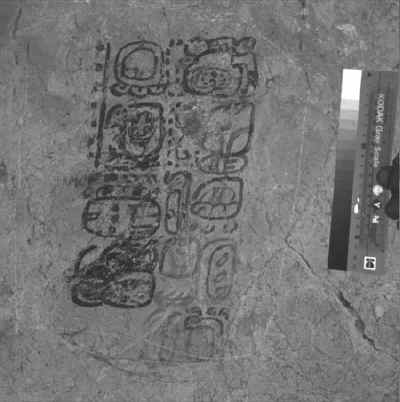| FAMSI © 1999: James E. Brady |
||
Ultraviolet and Infrared Filming of the Naj Tunich Inscriptions
Research Year: 1997 Multiple images of the Naj Tunich corpus of inscriptions were taken using a scientific grade digital camera and an array of filters. Selected optical filters, with a nominal bandwidth of 40 nanometers, were used to obtain images at wavelengths throughout the visible spectrum and extending into the near-infrared at 950 nanometers. The goal was to collect substantially enhanced images of faded inscriptions and hopefully detect vestigial remains of pigment in eroded drawings. Unfortunately, it appears that all pigment is missing in eroded drawings so dramatic improvements were not possible in those cases. Substantially improved images of faded drawings were noted and various methods of processing continue to be used to achieve further improvement. Among the new techniques of analysis used is one which determines pigment spectral contrast. This technique selects pixels from the pigment locations and compares them with pixels selected from the nearby background. Such comparisons can be made over a range of wavelengths producing a spectral signature of the pigment contrast with the background. This spectral signature can be used to identify differences in the pigment in the drawings at Naj Tunich. While Andrea Stone (1995:109) argues that at least two different pigments were being used, the spectral data suggests that there are at least three. More importantly the ability to document these differences spectrally reveals far more complexity in the Naj Tunich corpus than previously appreciated. Drawing 62, a profile human face, appears to have a uniform dark paint in the visible (550 nanometers) and hence will appear dark to the eye and to conventional photography (Figure 1a). Portions of the face, however, show significant fading in the near infrared (750 and 950 nanometers) perhaps due to a mineral-based pigment (Figure 1b & Figure 1c). The presence of two different pigment compositions in Drawing 62 suggests that the profile was either over-painted at the time of creation or, more likely, touched up at a later date.
The application of this new technique has opened a new dimension for the analysis of the Naj Tunich corpus. Besides the case of over-painting, the ability to characterize pigment composition using spectral contrast data has revealed an example of textual additions (Drawing 34) as well as basic relational differences and similarities between drawings. This, in turn, has led to an increased understanding of both the temporal and artistic complexity of the inscriptions themselves and their setting.
Click to download the drawings in PDF format: Drawing 4 (1.79 MB) The PDF files require Adobe Acrobat Reader.
Submitted 02/01/2000 by:
|
||
| Return to top of page | ||
|
Text links to all pages at this site are available at the FAMSI INDEX |
||


